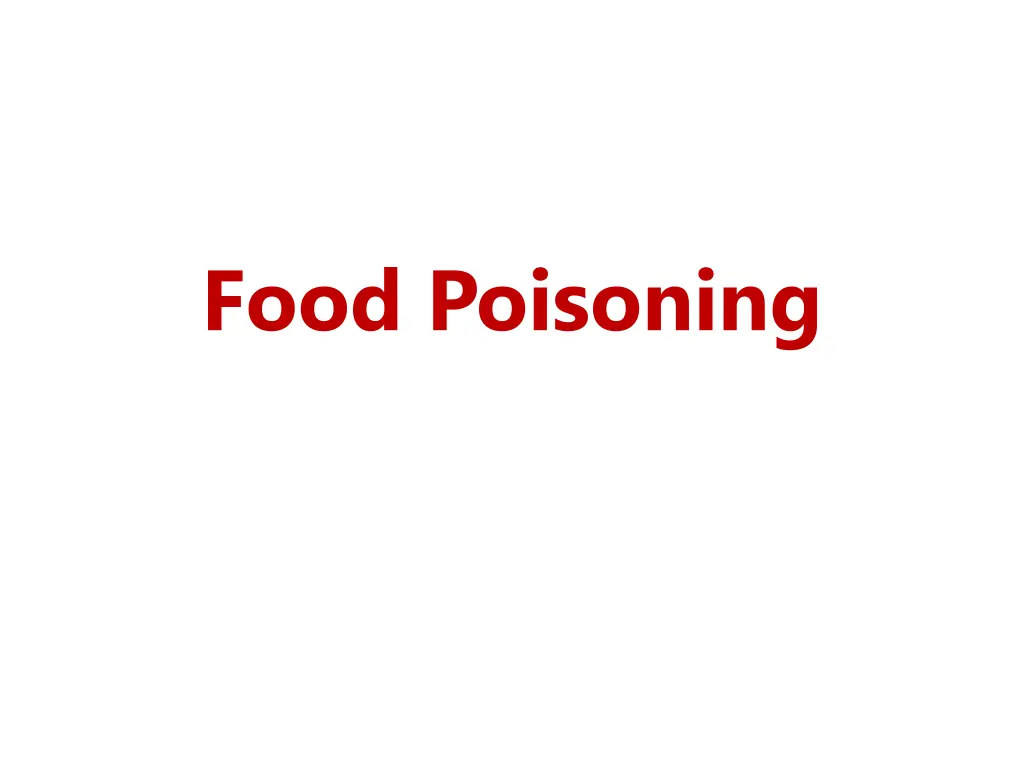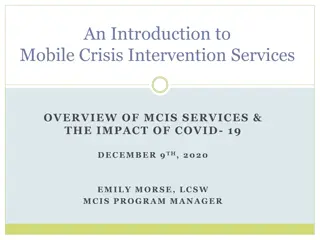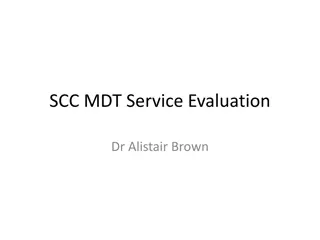
Understanding Bacterial Food Poisoning Mechanisms
Explore the major pathogenic mechanisms of bacterial food poisoning, including toxin production and toxin-mediated illnesses caused by various bacteria like Staphylococcus aureus, Clostridium perfringens, Bacillus cereus, and more. Learn about the symptoms, causative agents, lab diagnosis, and treatment options associated with food-borne illnesses in this comprehensive guide.
Download Presentation

Please find below an Image/Link to download the presentation.
The content on the website is provided AS IS for your information and personal use only. It may not be sold, licensed, or shared on other websites without obtaining consent from the author. If you encounter any issues during the download, it is possible that the publisher has removed the file from their server.
You are allowed to download the files provided on this website for personal or commercial use, subject to the condition that they are used lawfully. All files are the property of their respective owners.
The content on the website is provided AS IS for your information and personal use only. It may not be sold, licensed, or shared on other websites without obtaining consent from the author.
E N D
Presentation Transcript
Learning objectives Learning objectives At the end of the session, the students will be able to: Enumerate the microbial agents of food poisoning Describe the pathogenesis, clinical manifestations of Staphylococcal food poisoning Describe the pathogenesis, clinical manifestations of Bacillus cereus food poisoning Describe the pathogenesis, clinical manifestations of Clostridium perfringens food poisoning Describe the pathogenesis, clinical manifestations of Botulism Discuss the lab diagnosis of food poisoning Discuss the treatment of food poisoning
Introduction Introduction Illness contaminated either with microorganisms or their toxins acquired through consumption of food/ drink Usually results in common-source outbreak of diarrhea 600 million people affected with food-borne illness & 4.2 lakh die every year 40% children under 5 years of age affected, 1.25 lakh deaths every year Symptoms vary (abdominal pain, vomiting, diarrhea, fever, neurological, hepatic, renal syndromes)
Causative agents Bacterial Salmonella typhi and S. paratyphi Shigella spp Staphylococcus aureus Vibrio cholerae O1, O139 Vibrio parahaemolyticus Yersinia enterocolitica Aeromonas hydrophila Bacillus cereus Brucella spp Campylobacter jejuni Clostridium botulinum Clostridium perfringens E. coli Listeria monocytogenes
Non-Bacterial Giardia lamblia Taenia solium and T. saginatum Toxoplasma gondii Trichinella spiralis Trichuris trichura Trypanosoma cruzi Viruses Hepatitis A virus Hepatitis E virus Noro virus Poliovirus Rotavirus Natural toxins & chemicals Marine toxins Mycotoxins Mushroom toxins Plants intoxicants Pesticides Toxic metals Parasitic Ascaris lumbricoides Cryptosporidium spp Cyclospora Echinococcus spp Entamoeba histolytica
Major pathogenic mechanisms of Bacterial food poisoning: Toxin mediated Toxin production in- vivo (Toxico-infection) Clostridium perfringens Preformed toxins Staphylococcus aureus Bacillus cereus (long incubation) Bacillus cereus (short incubation) Clostridium botulinum ( infant botulism) ETEC Clostridium botulinum STEC Vibrio cholerae Vibrio parahemolyticus
Microbial agents of food poisoning Microbial agents of food poisoning Organisms Symptoms Common food sources 1- 6 h incubation period Staphylococcus aureus Vomiting, diarrhea, abdominal cramps Ham, poultry, salad, mayonnaise, pastries, dairy products Fried rice Bacillus cereus Vomiting, diarrhea, abdominal cramps 8- 16 h incubation period Clostridium perfringens Abdominal cramps, Beef, poultry, legumes, gravies Meats, vegetables, dried beans, cereals diarrhea Abdominal cramps, diarrhea B. cereus
Organisms Symptoms Common food sources >16 h incubation period Vibrio cholerae Watery diarrhea Shellfish, water Enterotoxigenic E. coli Watery diarrhea Salads, cheese, meat, water Enterohemorrhagic E. coli Bloody diarrhea Ground beef, salami, milk, raw vegetables, apple juice Non-typhoidal salmonellae Inflammatory diarrhea Meat, eggs, milk, juice, raw fruits and vegetables Shigella species Dysentery Potato, egg salad, lettuce, raw vegetables Vibrio parahaemolyticus Dysentery Raw or undercooked shellfish, particularly oysters
Organisms Symptoms Common food sources >16 h incubation period Campylobacter jejuni Inflammatory diarrhea Poultry, raw milk/water Clostridium botulinum Flaccid paralysis, diplopia, dysphagia Homemade improperly canned food, and honey (infants) Soft cheeses, raw sprouts, meats, seafood, and milk Salads, fresh fruits, shellfish (such as oysters), or water Raw fruits or vegetables and herbs Listeria monocytogenes Fever and myalgia (pregnant women) Norovirus Watery diarrhea, vomiting, abdominal cramps Watery diarrhea, abdominal cramps Cyclospora Mycotoxicoses (6-24h) Depends on type of fungal toxins Nuts, maize, wheat, cereals, etc.
Staphylococcal Food Poisoning Caused by contamination of food from infected human carriers Organisms multiply & produce enterotoxin (preformed toxin) Enterotoxin is expressed by nearly 50% of S. aureus strains 15 serotypes- A E, G P; superantigens (Type A is most common) Site of action: heat stable toxin, resistant to gastric juice; stimulates vagus nerve & vomiting center of brain & stimulates intestinal peristaltic activity
Symptoms: nausea, vomiting, diarrhea, hypotension, dehydration; resolve within 8- 10 hrs Food items involved- ham, poultry, salad, mayonnaise, pastries, dairy products Detection of enterotoxin in food- ELISA or latex agglutination test, detecting enterotoxin gene by PCR Treatment is entirely supportive by correcting fluid & electrolyte imbalance
Bacillus cereus Infections Gram-positive spore bearing motile bacillus. Normal habitant of soil Food items involved- vegetables, milk, cereals, spices, meat poultry Symptoms- due to two types of toxins 1. Diarrheal toxin (diarrheal type of food poisoning) 2. Emetic toxin (emetic type of food poisoning; heat stable preformed toxin resembling S. aureus enterotoxin)
Characteristics Emetic type Diarrhogenic type Toxin Emetic toxin Diarrheal toxin Resembles Preformed toxin resembling S. aureus enterotoxin resembles E. coli heat labile enterotoxin MOA Heat resistant spores of B. cereus survive boiling; germinate, produce toxin Toxin secreted by bacteria after entering intestine Food involved Consumption of contaminated fried rice Symptoms Vomiting, diarrhea, abdominal cramps Diarrhea, abdominal cramps are characteristic but vomiting is uncommon IP 1-6 hrs 8- 16 hrs
Other manifestations - Ocular disease: keratitis & panophthalmitis following trauma - Systemic infections: endocarditis, meningitis, osteomyelitis, pneumonia (presence of medical device or intravenous drug use predisposes)
Laboratory Diagnosis Sample- Stool Culture- Selective media; MYPA (mannitol, egg yolk, polymyxin B, phenol red and agar Treatment Susceptible to clindamycin, erythromycin, vancomycin, Tetracycline Resistant to penicillin (by producing -lactamase) & trimethoprim
Clostridium perfringens food poisoning Gram- positive spore forming (sub terminal) obligate anaerobic bacilli Capsulated & non motile Food poisoning caused by C. perfringens type A enterotoxin (encoded by cpe gene) Incubation period- 6- 24 h Infective dose- about 108 viable vegetative bacilli producing enterotoxin
MOA- Due to survival of heat- resistant spores in inadequately cooked beef meat, poultry, or legumes. - After ingestion, toxin is produced in the intestinal tract Symotoms- moderate to severe abdominal cramps, diarrhea; vomiting, fever are uncommon Course of disease- begins suddenly, is self-limited <24 hrs Diagnosis is by detection of entertoxin in feces by enzyme immunoassay C. perfringens mainly causes skin and soft-tissue infections (gas gangrene)
Clostridium botulinum- Botulism Botulism Gram- positive spore forming obligate anaerobic bacilli Clinical syndromes vary from food poisoning, wound infection to infant botulism Incubation period- 18- 36 h Pathogenesis - Due to production of neurotoxin botulinum toxin (BT) - Toxin is synthesized as nontoxic protoxin; requires trypsin or other proteolytic enzymes to convert into active form
Mechanism of Action of Botulinum Toxin (BT) Toxin is transported via blood to peripheral cholinergic nerve terminals Most common nerve terminal sites are neuromuscular junctions, postganglionic parasympathetic nerve endings, & peripheral ganglia Binds to acetylcholine receptors on nerve terminals at NMJ, blocking release of acetylcholine, leading to flaccid paralysis
BT is an exotoxin, produced intracellularly, appears outside only after autolysis of bacterial cell Recovery: Blocking of acetylcholine release is permanent, but action is short lasting & recovery occurs in 2- 4 mo (after new terminal axons sprout) Serotype- 8 serotypesofBT- A, B, C1, C2, D, E, F, G
Clinical Manifestations Clinical Manifestations Diplopia, dysphasia, Types of Botulism dysarthria Food-borne botulism Descending symmetric Wound botulism flaccid paralysis of Infant botulism voluntary muscles Adult intestinal botulism Deep tendon reflexes Iatrogenic botulism Constipation Inhalational botulism Respiratory muscle paralysis, may lead to death
Consumption of foods contaminated with preformed BT M.c source: Homemade improperly canned or fermented food & beverages Food-borne botulism Contamination of wounds with C. botulinum spores Absence of gastrointestinal features Wound botulism Contaminated food (usually honey) with spores of C. botulinum in children 1 yr Spores germinate in intestine, release toxin Inability to feed, weakened voice, ptosis, floppy neck, weakness (floppy child syndrome) Self-limiting, supportive care Rarely, progresses to generalized flaccidity, respiratory failure & sudden death Infant botulism
Rarely, in patients with suppressed normal flora, colonized clostridial spores may germinate producing toxin Adult intestinal botulism Injection of overdose of toxin while used for therapeutic purpose Iatrogenic botulism Inhalational botulism Aerosolization of spores may occur as in act of bioterrorism
Therapeutic uses: As BT produces flaccid paralysis, it can be used therapeutically for treatment of spasmodic conditions- strabismus, blepharospasm, myoclonus Botulinum toxin is also produced by other clostridia- C. butyricum , C. baratti,C. argentinense
Laboratory Diagnosis Isolation of Bacilli Toxin Demonstration- Mouse Bioassay
Treatment Meticulous intensive care support is needed Botulinum antitoxin- administered immediately on clinical suspicion, without waiting for laboratory confirmation Earlier the administration, better is the cure rate; antitoxin can neutralize unbound free toxin molecules In wound botulism, suspected wounds & abscesses should be cleaned, debrided & drained promptly Antibiotics- penicillin or metronidazole may be useful
Facts to note Food poisoning outbreak must be suspected when : an acute illness affecting 2 or more persons with similar gastrointestinal or neurological manifestations who have shared a common meal
Vulnerable population Elderly People Babies People with Chronic diseases Pregnant Women
Laboratory diagnosis Laboratory diagnosis Meticulous history taking regarding ingestion of specific foods & time of onset of diarrhea after a meal can provide clues to the bacterial cause of the illness Vomitus, stool or the suspected food materials are the ideal specimens
Processing of Food Specimens Viable Plate Count (Direct Quantification) Identify & report no. of colonies as such or /g sample Pre-enrichment Culture (helps in recovery of damaged pathogen) Toxin Detection- ELISA, LAT, PCR
Treatment of food poisoning Treatment of food poisoning Adequate rehydration & electrolyte supplementation ORS or IV solutions (e.g. isotonic sodium chloride solution, Ringer lactate solution) Other symptomatic t/t- absorbents (e.g. Aluminum hydroxide) & antisecretory agents (e.g. bismuth subsalicylate) Antitoxin such as heptavalent botulism equine serum antitoxin Antibiotics- penicillin or metronidazole
Antibiotics: Usually antibiotics do not play much role Indicated for shigellosis, where fluoroquinolone (e.g. ciprofloxacin) is first-line agent In suspected cholera, azithromycin is drug of choice
Case history : 1 A kid returned from a birthday party and began vomiting 6- 7 hrs later. There was no fever or loose stools. Next morning, parents rang up the school to inform when teachers let them know that 6 other childrenwho had attended party reported with similar illness. The common dish children ate was pineapple pastry.
Q. Choose the appropriate sample Samples- food particles, vomitus , stool, swabs from nostrils or skin lesions of food-handlers Q. Choose the test to be performed 1 6 h incubation period Staphylococcus aureus Vomiting, diarrhea, abdominal cramps Ham, poultry, salad, mayonnaise, pastries, dairy products 1. Food sample plated on Blood agar & selective media 2. Send sample to reference lab for enterotoxin detection & phage typing 3. Stool sample plated on blood agar, MAC, selective media 4. Send sample to reference lab for enterotoxin detection & phage typing
The pastry was recovered and cream tested positive for Staphylococcus aureus. Further investigations found that a nasal swab taken from the cook was positive for S. aureus.
Case history : 2 A regional public health facility received reports of acute Gastrointestinal illness among children & staff of a child day care centre who ate oriental fried rice kept at ambient temperature ,in dinner became ill subsequently. Earliest symptom included nausea & later on abdominal cramps& diarrhoea .Food particles, stool samples & vomitus from suspected cases were found to be positive for Bacillus cereus.
Q. Choose the appropriate sample Samples- food particles, vomitus , stool Q. Choose the test to be performed Bacillus cereus Vomiting, diarrhea, abdominal cramps Fried rice 1 6 h incubation period 1. Food, stool sample plated on Blood agar & selective media (polymyxin agar) 2. Send sample to reference lab for toxin detection
Food particles, stool samples & vomitus from suspected cases were found to be positive for Bacillus cereus
Case history : 3 Mrs. Smitha was admitted to hospital with c/c of nausea, vomiting & cramps. Her daughter stated that she is also complaining of blurred vision. Nurse noticed drooping of eyelids & facial muscles of both sides . Her daughter said that she cans her own vegetables & had eaten from those jars yesterday. Paralysis starts developing & soon after her breathing ceases. She was placed on ventilator.
Q. Choose the appropriate sample Samples- food particles, stool Q. Choose the test to be performed Clostridium botulinum (kerner s disease) Flaccid paralysis, diplopia, dysphagia Homemade improperly canned food, honey (infants) 18-36 h incubation period 1. Food, stool sample inoculated in Robertson s cooked broth & plated on Blood agar & selective media (egg yolk agar) in anaerobic condition 2. Send sample to reference lab for toxin neutralization assay
Food, stool samples were found to be positive for Clostridium botulinum
Case history : 4 A recent outbreak of foodborne illness was reported after a mass staff luncheon at a school where beef was cooked. Beef was not refrigerated & kept long in kitchen before serving. 103 people got sick with cramps , diarrhoea & dehydration.
. Choose the appropriate sample Samples- food particles, stool Q. Choose the test to be performed Clostridium perfringens Abdominal cramps, diarrhea Beef, poultry, legumes, gravies 8-16 h incubation period 1. Food, stool sample inoculated in Robertson s cooked broth & plated on gentamicin Blood agar in anaerobic condition 2. Send sample to reference lab for enterotoxin detection
Food & stool samples taken from cases tested positive for Clostridium perfringens







